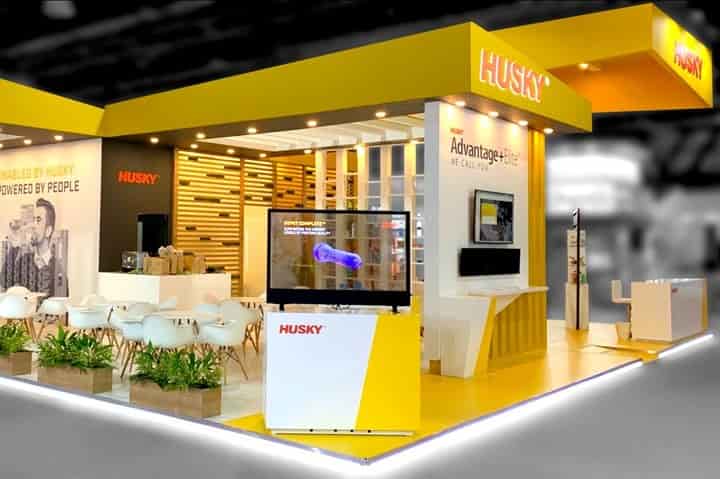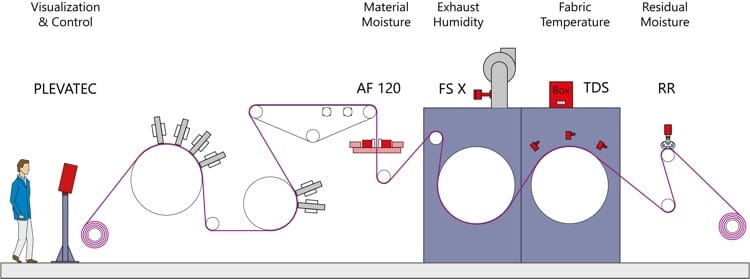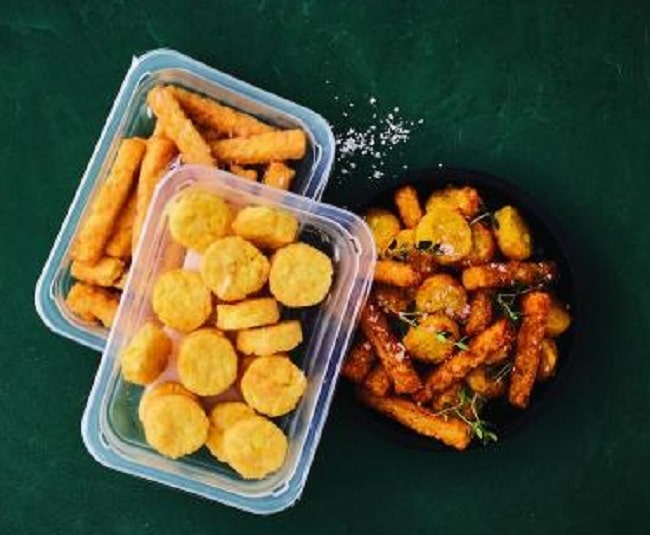PET-Preform – MMF – EVO-bio-Yarn 26-11-2022 - Arhive
PET-Preform – MMF – EVO-bio-Yarn
-Sabic launches value chain partnership with Jinming and Bolsas to foster innovative flexible film packaging solutions
- SABIC’s close collaboration with Guangdong Jinming Machinery Co., Ltd., and Bolsas de los Altos will focus on application development activities for flexible packaging.
- The collaborative efforts will augment SABIC’s position in the Americas as a polyethylene resin supplier with local production capabilities
SABIC, a global leader in the chemicals industry, has teamed up with Guangdong Jinming Machinery Co., Ltd., a plastic packaging equipment manufacturer and Bolsas de los Altos, a leading plastic film and packaging converter to support growth of polyolefin based innovative applications in the flexible packaging segment. Engagement with value chain players remains critical to SABIC’s vision of bringing market driven innovation to customers. By exchanging mutual expertise on polymer technology and processing, this collaboration will secure the development of a robust applications pipeline based on current and future market trends.
Sustainability trends continue to transform the flexible packaging industry. As a result, incumbent film structures need to be updated to conform to latest circularity needs. A partnership involving SABIC’s deep materials knowledge, Jinming’s equipment manufacturing excellence and Bolsas’ converting capabilities can address these challenges. The collaboration will provide an outlet to test and validate performance of SABIC polyolefin resin products including polyethylene resin offerings from Gulf Coast Growth Ventures (GCGV) and from TRUCIRCLE™ , SABIC’s commitment to circularity for plastics. The collaborative efforts will feature installation of Jinming’s multilayer coextrusion machinery at Bolsas’ Mexico facility. PET-Preform – MMF – EVO-bio-Yarn
Waleed Al-Shalfan, Vice President Polymers Technology & Innovation at SABIC, said: “At SABIC, we continue to invest in market driven innovation to deliver value added solutions to our customers. We understand that partnerships with the right value chain players have the potential to bring newer, game changing innovations to the market faster. The current partnership with Jinming and Bolsas holds great promise to tap into mutual capabilities and adapt global trends in flexible packaging applications to regional needs.”
Mars Ma, General Manager of Jinming, commented: “It’s a great milestone to sign off this MOU which officially kicks-off the strategic collaborations among the 3 parties. It’s an excellent example of value chain collaboration. We are glad to work together with SABIC and Bolsas to address market needs via innovative solutions”
Guillermo Lopez Orozco, Founder and CEO of Bolsas de los Altos, added: “As a leading provider of plastic packaging, Bolsas de los Altos is excited to expand into the broader flexible packaging market. Flexible packaging has shown remarkable resilience in a market disrupted by a global pandemic and supply chain issues. The installation of multilayer coextrusion equipment at our Mexico facility made possible due to our collaborative partnership with Jinming and SABIC will allow us to target several new applications including long term sustainability trends in this space.”

-Complete End-to-End PET Preform Production
Husky’s new HyPET Complete is a connected production cell for molding preforms developed to address ongoing challenges faced by food and beverage packaging producers.
At Gulfood Manufacturing 2022 in Dubai, Husky Technologies debuted the HyPET Complete—a full manufacturing cell for the production of PET preforms billed by the company as the industry’s only complete, end-to-end, connected production system. Husky says HyPET Complete is built around its latest generation of HyPET systems, including those tailored for the production of rPET, and it includes a purpose-built drying solution, optimized energy management, enhanced melt control, automated mold cleaning, integrated part quality inspection, and more.
The company says this complete cell will help food and beverage packaging producers better deal with current market issues, including rising energy and material costs; supply chain fluctuations; skilled labor shortages; and demands to be more sustainable.
HyPET Complete applies an end-to-end approach incorporating factory planning and tooling lifecycle optimization, workforce training and development, a fully digitized delivery model and OEM parts, as well as the company’s Advantage+Elite predictive remote-monitoring platform. PET-Preform – MMF – EVO-bio-Yarn
Designed to enable producers to navigate through today’s most prevalent challenges, HyPET Complete is particularly relevant to producers who are looking for more energy efficient manufacturing processes and packaging materials, such as PET, to offset fluctuating costs.

-Reducing gas consumption in spunlace production
Researchers at the Center of Excellence in Nonwovens at the STFI (Sächsisches Textilforschungsinstitut) have developed an energy efficient system for drying spunlace fabrics.
As part of the project, the Chemnitz, Germany-based institute has installed a measurement and control system from Pleva which, designed to reduce gas consumption and optimize energy efficiency, includes sensors for measuring residual moisture, fabric temperature, exhaust humidity and a process control system.
Following the spunlace process, the high residual moisture content of the fabric means that the system begins with a contactless microwave moisture measurement using an AF 120 sensor. The sensor consists of two measuring heads, the transmitter and the receiver. The measuring principle is based on microwave absorption by the water content of the nonwoven. The more water there is in the nonwoven, the lower the signal at the receiver.
The magnitude of the absorption is a measure of the absolute residual moisture content of the nonwoven. This determination of the water content is used to optimize the subsequent dryer.
Inside the drum dryer, the nonwoven temperature is monitored with three TDS infrared sensors. This ensures that the quality of the spunlace nonwoven is not affected by overheating. The used infrared measurement is based on heat radiation exchange between the spunlace nonwoven and the infrared sensor. The measuring range of the TDS sensor is 0 – 250°C. PET-Preform – MMF – EVO-bio-Yarn
The exhaust air humidity in the screen drum dryer is monitored by the FS X air humidity sensor and can be regulated in the production process via an exhaust flap control. The absolute air humidity (water vapor) in the exhaust exit tube of the drum dryer is measured while the setting of the optimum air humidity value should be e.g. 90 g water/kg air under production conditions for textile dryers.
For measuring the low residual moisture after the drum dryer and therefore for controlling the fibre-dependent drying temperature, the system uses an RR sensor.
Used in applications of up to maximum of 30% residual moisture, this is a tandem roller sensor which monitors the residual moisture measurement in the centre of the nonwoven. The active principle is the contact measurement of very low residual moisture based on electrical conductivity. The defined contact pressure and perfect alignment to the nonwoven with the tandem roller sensor ensure the highest accuracy while a further advantage is the compensation of electrostatic charge at low residual moisture levels, particularly for synthetic fabrics.
PlevaTec
With the process visualization, the fabric temperature, residual moisture and exhaust air moisture measured by the corresponding sensors are monitored and the process values are adjusted on the spunlace system
Andreas Nestler, Research Associate at STFI highlights the newly achieved possibilities: “The profile of the residual moisture after the AquaJet and the drying temperature (fabric temperature) allow new optimization possibilities in the drying process. Gentle heating curves become possible, which prevent nonwoven surface damage. Also, the process and tolerance monitoring enables the improvement of the nonwoven quality, as it is not exposed to unnecessarily high drying temperatures.”
This is also an important aspect in terms of sustainability, as there are no more second choice goods or rejects, which ensures waste reduction and the subsequent saving of valuable resources. A comprehensive 10-day trend display/history and recipe management is also possible. PET-Preform – MMF – EVO-bio-Yarn
The drying process is carried out with highest energy efficiency and continuous data monitoring. The process visualization is a modular visualization and control system for the material moisture and for the drying process.
At various customer trials with this implemented system of sensors and process control, the STFI says it achieved the goal of an energy efficient nonwoven production line. “With the technology it was possible to lower the drying temperature by 40°C (from 100°C to 60°C) running on target moisture. For viscose the residual moisture was set to 5-7%. In summary, with these optimizations, a used gas volume reduction of 20% was achieved with a given full transferability to industrial dryers.”

-Oerlikon’s sustainable plant solutions for the manmade fiber industry in India and Bangladesh
The Swiss Oerlikon Group’s Polymer Processing Solutions division will be presenting itself at the ITME 2022 under the banner of ‘From Melt to Yarn, Fibers and Nonwovens’. The international trade fair is taking place in the India Exposition Mart Ltd., Noida, close to New Delhi, India. Between December 8 and 13 this year, more than 1800 exhibitors and over 150.000 visitors are expected. Oerlikon will be presenting a broad range of products and services focused on manufacturing and processing manmade fibers. Oerlikon’s team of experts is very much looking forward to seeing you at booth C15 in Hall 11.
In addition to various new component exhibits from the fields of continuous polycondensation including gear metering pumps, filament (POY, FDY, IDY, BCF) and staple fiber spinning, texturing as well as nonwovens production, the dialog with all customers will now more than ever after almost 6 years without an ITME in India be again at the center of the trade show activities. PET-Preform – MMF – EVO-bio-Yarn
For Oerlikon, this will be the third major appearance in the region in the fourth quarter of this year, after having had in November two exciting and interesting customer events in Daman, India, and Dhaka, Bangladesh. This is also because the important markets of India and Bangladesh are currently still standing out in terms of their investment behaviour and currently offer good opportunities for further polymer processing projects. More than 250 participants discussed the technology and market analysis presentations held by Oerlikon experts, at the Oerlikon Technology Symposium in Daman, India. Afterwards, all guests celebrated the 100th anniversary of Oerlikon Barmag and the 75th independence of India with a big gala event.
India right now continues to have above-average economic growth with a 6.8% Gross Domestic Product (GDP) for 2022. Experts speak of “a bright spot in a global gloom”. Some facts and figures:
▪ The textile industry in India is one of the largest in the world with a large raw material base and manufacturing strength across the value chain.
▪ India is the 2nd largest producer of MMF Fiber. India is the 6th largest exporter of textiles and apparel in the world.
▪ India became the second-largest manufacturer of Personal Protective Equipment (PPE) kits in the world.
▪ India is the 6th largest producer of technical textiles with a 6% Global Share (12% CAGR), the largest producer of cotton and jute in the world.
▪ The industry contributes to 7% of industrial output in value terms, 2% of India’s GDP and 12% of the country’s export earnings.
▪ The share of textile, apparel and handicrafts in India’s total exports was 10.62% in 2021-22.
▪ The textile industry in India is one of the largest economic sectors that contributes the most to job creation in the country. It engages 16.73 lakhs of people consisting of 10.28 % of the total employment share.
▪ The domestic apparel and textile industry in India contributes 2.3% to the country’s GDP, 7% of industry output in value terms.
▪ The domestic textiles and apparel industry stood at USD 152 bn in 2021.
“Major growth of textiles will come from Manmade Fiber industry”, said Shri Piyush Goyal, Union Minister of Textiles, Consumer Affairs, Food & Public Distribution and Commerce & Industry at the end of October in India. He suggested that the industry should understand each other and work in synergy to amicably resolve the issues among the producers and users of polyester in the entire value chain. Industry representatives responded that they are hopeful of achieving the export of 100 billion USD in the next 5 to 6 years.
Success in the markets
In India, however, things continue to go very well for Oerlikon in other respects. In the middle of the year, the joint venture Oerlikon Barmag Huitong (Yangzhou) Engineering Co. Ltd. also recorded a major success. PET-Preform – MMF – EVO-bio-Yarn

-Palsgaard, Korean Converter Collaborate to Optimize Shelf-Life of Packaged Food
Aesthetics, safety, and sustainability of sensitive food packaging is addressed with a plant-based, food-grade anti-fogging additive.
Palsgaard, a supplier of plant-based additives for the plastics industry, says that its Einar 611 bio-based anti-fog surfactant has been successfully specified by a major Korean supplier of food-grade polyethylene (PE) film products. The customer had been looking for a cold anti-fogging additive that would effectively protect the packaged food from spoilage by preventing the formation of condensation droplets on the inside of the film at low concentration levels. At the same time, the surfactant had to eliminate regulatory concerns with regard to its chemistry and provide superior functional performance at cost-effective low concentration. PET-Preform – MMF – EVO-bio-Yarn
“The importance of food packaging and its role is ever-changing, from the mere protection of food items from the outside in nice packaging to concerns about food safety and product shelf life,” says Ulrik Aunskjaer, Global Business Director for Bio-Specialty Polymer Additives at Palsgaard. “Our plant-based Einar 611 anti-fog has proven itself a perfect choice in this PE film application to minimize the risk of moisture accumulating in small reservoirs on the inner surface of the packaging film, where bacteria could grow and then drop down and spoil the food.”
Effective alternative to conventional anti-fogging chemistries
As a renewable polyglycerol ester made of certified palm oil from Malaysia that does not compete with food or feed sources, Einar 611 has been developed as a highly effective replacement for conventional anti-fogging chemistries, such as glycerol monooleate or sorbitan esters, in demanding PE film formulations designed for sensitive food packaging. With anti-fog performance matching or exceeding that of non-vegetable fossil-based incumbents, it reportedly delivers excellent results in low-density and linear-low-density PE as well as co-extruded and laminated PE film at low loading levels — typically 0.2% to 0.4% — for both cold- and hot-fog applications. Moreover, it has proven itself as an ideal additive in PE masterbatches and shows no adverse effects on the mechanical, optical, or barrier properties of the film, while offering high heat resistance and low volatility, according to Palsgaard. The bio-based anti-fog surfactant is available in paste form.
From a perspective of food safety, the long-lasting anti-fog performance of Einar 611 can make a significant contribution to the reduction of food waste by preserving its freshness. The additive supports a clear view on the packaged product, which promotes its consumer appeal over a longer shelf-life, and meets all global food-contact standards, including kosher and halal. PET-Preform – MMF – EVO-bio-Yarn
“While there is opposition from the food industry to palm oil such as in France, when sustainably produced, palm oil is the highest yielding plant oil,” commented Ulrik Aunskjaer, Director, Bio-Specialty Additives at Palsgaard. The company also grows its own rapeseed in Europe as an alternative bio-based raw material.
Sustainable production practices
In addition, Einar 611 anti-fog is produced in CO2-neutral factories, thus helping PE film manufacturers, masterbatch makers, and processors to minimize their Scope 3 emissions and mitigate fossil depletion. According to the Greenhouse Gas Protocol, Scope 1 refers to direct emissions from production processes, Scope 2 to indirect emissions from energy use, and Scope 3 to all other indirect emissions, such as from material supplies, packaging, and transportation.
Along with expanding its production capacities, Palsgaard continues investing in its own Scope 1 and Scope 2 carbon-neutral production processes. Its Juelsminde site in Denmark achieved Scope 1 neutrality in 2018, but further investments will now be required as capacity is added.
The company is constructing a biogas plant that will employ wastewater from Palsgaard and become operational in early 2023, covering 10% of the required gas supply on-site. It already operates a biogas plant at the Juelsminde municipal wastewater treatment plant in a public-private partnership. PET-Preform – MMF – EVO-bio-Yarn
Another project scheduled to commence in spring 2023 is the construction of a 60-acre solar power plant with an annual capacity of 60 GWh, generating sufficient renewable electricity to power all future capacity expansions currently planned at Juelsminde.

-Pangaia chooses Evo by Fulgar for activewear
Brand launches new generation activewear 3.0 made from bio-based materials.
Materials Science Brand Pangaia has chosen Evo bio-based yarn by Fulgar, the leading manufacturer of man-made fibres, for the launch of its new Activewear 3.0 collection,
The decision provides further confirmation of the green, innovative direction the brand is taking, reflecting its mission – to find innovative materials that promote biodiversity, eliminating petrochemical products and supporting a positive future for the climate.
“The activewear sector generally uses materials with entirely petrochemical origins, reflecting a need for significant benefits in moisture absorption and performance. However, the introduction of a greater number of bio-based materials means we’ve been able to replace fossil fuels with renewable resources. This is the choice we’ve made for Pangaia’s Activewear 3.0 collection. Our partnership with Fulgar and the use of Evo yarn has enabled us to create a new generation of sustainable, high-performance activewear,” says Amanda Parkes, Chief innovation officer of The Pangaia. PET-Preform – MMF – EVO-bio-Yarn
Evo by Fulgar yarn is made from castor oil, a renewable and sustainable resource. The castor oil plant, Fulgar says, grows spontaneously in arid regions, does not require large amounts of water areas and does not take up land that where food crops can be grown. The biomass from which Evo by Fulgar is formed by castor oil seed and the monomers used in the polymerisation process are partially or totally derived from castor oil.
In all, Fulgar explains, the yarn offers the characteristics of the finest quality nylon and is suitable for all textile applications, from sportswear to hosiery, as it is high-performance, very light, stretchy and breathable. It dries quickly, is non-iron and boasts natural thermal and bacteriostatic properties.
The extensive series of distinctive values and benefits provide maximum comfort and unique performance while respecting the natural world. As a result, they are perfectly in line with Pangaia’s philosophy of ‘high-tech naturalism’ and are the perfect solution for the creation of the new Activewear 3.0 capsule.
Made from 99.99% Evo nylon and 30% creora elastane, both of vegetable origin, the capsule is the brand’s most bio-based proposal so far. The evolution of Pangaia activewear is said to be an experience in revolutionary wearability, with seamless garments offering extensive benefits in terms of comfort and stretch, and in movement. With second skin properties, the garments create a sensation of light compression and enable wearers to keep cool and fresh for longer thanks to the patented PPRMINT treatment with natural peppermint oil. PET-Preform – MMF – EVO-bio-Yarn
“We’re very happy to be working once again side-by-side with Pangaia in its progress towards increasingly green collections, made possible by the properties of our ecological yarns. It’s a significant recognition of our long-standing commitment to eco-sustainable research and development towards an ethical, circular and increasingly sustainable activewear supply chain,” says Alan Garosi, Head of Marketing at Fulgar.
Pangaia’s Activewear 3.0 collection with Evo by Fulgar – available online at www.pangaia.com – comprises four key models in three colour versions: bra (€55), crop-top (€80 euro), shorts (€65 euro) and leggings (€100 euro) in black, leaf green and cerulean blue.

-It is time for a thorough debate on CO2 utilisation
There has never been a more exciting time for carbon capture, yet EU policies need to provide a predicable regulatory framework and allow for a strong business case, writes Koen Coppenholle, CEO of CEMBUREAU, the European Cement Associaton.
The past months have been marked by significant headways for Carbon Capture, Utilisation and Storage (CCUS) in the EU. A large number pilot and demonstration projects have been launched by cement companies across Europe, with the first of them becoming operational as early as 2024. PET-Preform – MMF – EVO-bio-Yarn
Recent ETS Innovation Fund calls also supported a great variety of CCUS projects, strengthening the EU’s global leadership on the technology. Politically, carbon capture is equally getting a strong momentum: Energy Commissioner Kadri Simson announced a Communication on a strategic vision during the recent CCUS Forum, whilst Executive Vice-President Timmermans highlighted at a recent CEMBUREAU event the crucial role that the technology will play.
These investments in CCUS in the cement industry should not surprise anyone. According to our sector’s Carbon Neutrality Roadmap, CCUS represents 42% of the cement industry’s emission reductions by 2050. Process emissions, roughly representing two thirds of cement manufacturing CO2 emissions, are unavoidable and even if we push hard on all other decarbonisation levers, carbon capture is indispensable to meet our carbon neutrality ambitions.
Yet, despite this renewed momentum, there is a high degree of uncertainty around the use of CO2 from industrial sources. This uncertainty was ignited by the Commission’s Communication on Sustainable Carbon Cycles (December 2021) which states that “fossil carbon should be replaced by more sustainable streams of recycled carbon from waste, sustainable biomass and directly from the atmosphere”. In the Communication, no timeline has been put on the replacement of ‘fossil carbon’. The recent Commission Draft Delegated Act on the greenhouse gas saving criteria for recycled carbon fuels does introduce such timeline, at least for the production of synthetic fuels. According to this proposal, CO2 from industrial sources can no longer be used after 2035 in the production of synthetic fuels.
This draft Delegated Act has been met with consternation within the EU cement industry. There are currently major CO2 utilisation projects under development – some of which are actually supported by the EU’s own ETS Innovation Fund – in the sector to develop synthetic fuels. These involve highly significant CapEx and OpEx, and are planned on a return on investments of several decades. These CO2 utilisation projects are actually vital for the decarbonisation of the sector, as many of the 200 cement kilns on the European territory are landlocked with no easily available CO2 storage-site within reach. Faced with unavoidable CO2 emissions, it is crucial that these plants have the possibility to re-use the CO2 they capture into fuels and products.
We do take the point made by the European Commission that synthetic fuels using industrial CO2 are not a fully “net zero solution”, to the extent that the captured CO2 is re-emitted into the atmosphere when the fuel is used by the airplane, ship or truck. However, even if not a carbon neutral solution, synthetic fuels (and the re-utilisation of CO2 in general) make a decisive contribution to climate mitigation in the short to medium term, by considerably reducing the amount of CO2 emissions and reducing reliance on fossil fuels. Faced with a climate emergency and a shortage of alternative CO2 sources in the short to medium term, why would the EU proceed with legislation that endangers the business case for a key decarbonisation avenue for the cement and transport sector altogether?
The very reasons behind the proposed phase-out of industrial CO2 are unclear, nor is the choice of 2035 as phase-out date. The Commission seems to consider 2035 as “long-term” which does, however, not coincide with business reality in sectors with investment cycles of 30-35 years. There is further no detailed impact assessment on the availability of what the Commission defines as sustainable sources of CO2. For DAC, forecasts estimate between 154 and 227 million tonnes by 2050 with no estimation of DAC/BECC availability for the trajectory 2030 to 2050 and only some reference to a 5 million tonnes target by 2030 in the Commission’s Sustainable Carbon Cycles Communication.
The publication of the draft Delegated Act highlights the need for a thorough debate on the future of CO2 use from industrial sources. PET-Preform – MMF – EVO-bio-Yarn
Such CO2 use is currently a key component of climate mitigation and decarbonisation initiatives in several energy-intensive sectors. More than ever, we need an open discussion on carbon use from industrial sources, covering both the continued need for carbon as feedstock for industrial production, and the level at which these needs can be met by the different sources of CO2.

PET-Preform – MMF – EVO-bio-Yarn
